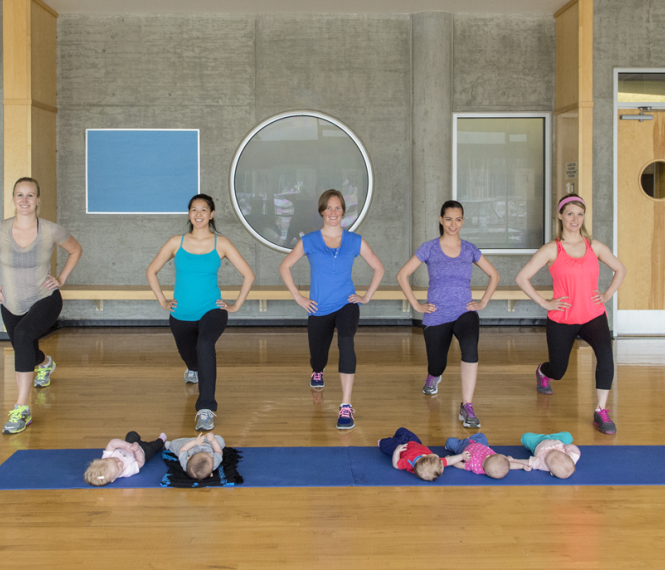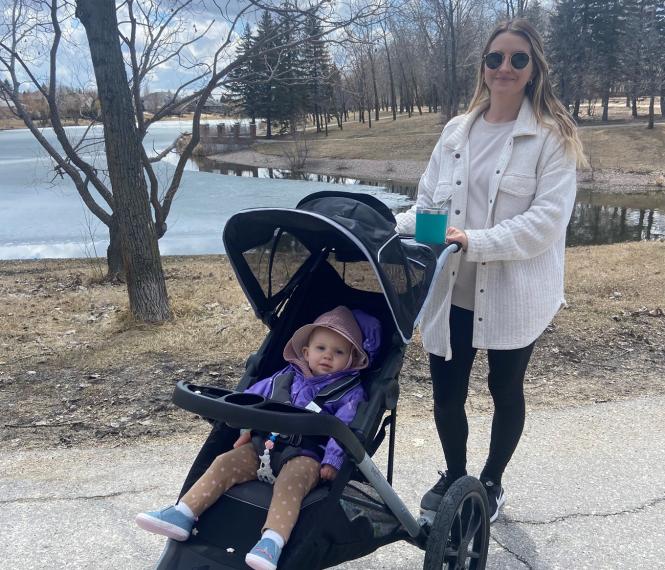Strength Training for Babywearing
Babywearing is a wonderful way to spend time with baby while getting useful things done: walks in nature, exercise, chores around the house, managing older kids and more. However, it’s also physically a LOT of work! Many people find babywearing can lead to a sore back and tired feet, especially as baby grows. If you are hoping to build in more babywearing time, but finding it taxing on your body, we suggest taking a pro-active approach by adding strength training into your routine.
Here are our strength training tips for babywearing:
- Prepare your pelvic floor.
Pregnancy, labour and delivery can all do a number on your pelvic floor. A weak pelvic floor can lead to back and hip pain, urinary incontinence and more. Babywearing adds additional weight and stress on your body and can worsen these symptoms if your body is not ready. Joining one of our classes like Parent & Baby Pilates, Postnatal Yoga and Infant Massage, or Postnatal Core Restore is a great foundation to improve your babywearing success. Check out our upcoming schedule for times and locations. If you’re in doubt, seeing a pelvic floor physiotherapist is highly recommended. Winnipeg Physiotherapists Specializing in Pre/Postnatal
- Be mindful of abdominal separation.
Diastasis Recti (DR), often called abdominal separation, occurs in about 50% (or more) of pregnancies in the 3rd trimester. DR occurs when there is stretching of the fascia (Linea Alba) that runs vertically between your rectus abdominis muscles. It usually occurs in the third trimester when your growing uterus puts the most strain on your abdominal muscles. DR isn’t painful, but it may lead to back pain, pelvis pain, and pelvic floor dysfunction. Again, babywearing puts extra strain on your core and may worsen these symptoms. Recommendations vary but you’ll likely want to limit your babywearing time to less than one hour per day until your core function is improved. Ask your Fit Together instructor how to check for abdominal separation, or see one our local physiotherapists as above.
- Babywearing itself is a workout! Build up slowly.
Many new parents are surprised by how tired they are. Babywearing is a good way to help you find more time to do things for yourself, or around the house. But it’s also a workout itself. For best results, build up the time spent with the baby carrier week by week. If you find your back or hips are getting very sore with babywearing, reduce time in the carrier. If you're looking for a class that incorporates babywearing, check out our Parent & Baby Barre, Adventure Club, or Babywearing Dance + Strength.
- Wear good footwear.
If you wore your running shoes all through your pregnancy, chances are it’s time to replace them after all the additional wear and tear, especially if you plan to babywear. New shoes will help cushion the extra weight of baby on your body. If you find yourself getting sore feet, it can help to choose running shoes over casual footwear, even inside the house. In winter, choose the most supportive footwear possible for the outdoor conditions.
- Keep good posture.
Posture is a HUGE factor in comfortable babywearing. Keep your shoulder blades dropped down your back (not rounded forward), shoulders over hips and pelvis in a neutral position. Try not to lean back while babywearing and keep the knees soft (not locked or hyperextended)
- Check the fit of your carrier.
So many of our participants are amazed at the difference an adjustment of their baby carrier can make! Aim for the waist strap sitting tightly just above the hips. The upper back strap should be in line with your bra strap. Baby should be high up on your chest (usually higher than you think) with the top of their head “kissable” under your chin. With our variable Manitoba climate, know that you’ll need to adjust your carrier each time you change jackets/ layers or if another person uses the carrier. It’s worth it to take the time to do this! Ask your Fit Together instructor for help adjusting your carrier or drop in to Scout Coffee & Tea’s Babywearing Support Meet Ups.
- Strengthen your upper back, core and legs.
Babywearing is a full body workout that requires a strong core, upper back and legs. Focus on exercises that help you maintain proper posture, and build strength in the lower body.
Mini Strength Workout for Babywearing
Complete the following workout 2-3 times per week, with baby NOT in the carrier
- 10 pelvic floor contractions x 2
- 30 seconds cat-cow on hands and knees x 2
- 30 seconds “super mom” on hands and knees x 2
- 30 seconds row with weights (or band hooked on a railing) x 2
- 30 seconds squats x 2
- 30 secs flye with weights (or pull band apart at shoulder/chest height) x 2
- 30 seconds lunges x 2
Babywearing is a wonderful way to bond with baby and get more done in a day. By taking a proactive approach to strengthening your body as baby grows, babywearing can be enjoyable and comfortable for many months to come.
Check out our upcoming schedule or ask your Fit Together instructor if you need more advice!
Aileen & the Fit Together team



